Moja Island: learning about renewable energy sources Teach article
Renewable energy is not only important in the developed world; in developing countries, it may be a prerequisite to overcoming poverty. Marlene Rau introduces a teaching activity from Practical Action.
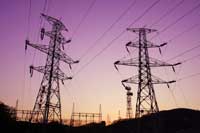
tend to take for granted the
availability of electricity
Image courtesy of Gatsenko
Alexander / iStockphoto
Electricity is an important factor in overcoming poverty, as the United Nations Development Programmew1 states. In communities without electricity, children are often unable to attend school because they are needed to help collect biomass for fuel – but education is a crucial contributor to escaping poverty.
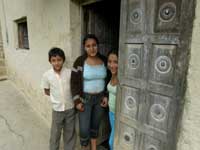
home is connected to a micro
-hydro scheme that
generates electricity to
enable the family to listen
to the radio, watch TV and
have lighting
Image courtesy of Practical
Action / Warwick Franklin
In addition, without access to radios, computers or the Internet, communities have no access to vital information about farming techniques, or to flood warnings or local news. Lack of energy also means that people struggle to start a simple business that could help them out of poverty.
Practical Action (previously known as the Intermediate Technology Development Group) is a UK-based development charity that has been working with the world’s poorest communities for more than four decades, focusing on energy and technology as a catalyst for change. The education section of the charity’s websitew2 provides a range of educational resources and teaching materials on sustainable engineering, climate change and renewable energy.
This article presents one of the classroom activities: Moja Island, in which students consider the options available to the four communities living on a fictitious island and select the most appropriate technologies to meet their needs. Aimed at students aged 11-16, this 1-2 hour activity reinforces their understanding of renewable energy sources.
The Moja Island activity
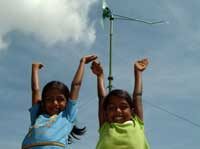
are looking forward to
having light in their home
generated by a small wind
turbine
Image courtesy of Practical
Action / Zul Mukhida
Did you know that one fifth of all people in the world have no access to electricity? Of these, 85% live in rural areas (International Energy Agency, 2010). Furthermore, most people who do have access in remote areas – especially in developing countries – are not connected to a national grid, but have to find other ways to generate power. The main reason is that grid extension is often not cost-effective: the cost per MWh delivered through an established grid is lower than through off-grid systems, but the cost of extending the grid to only a few people in remote regions can be very high. Long-distance transmission systems also lose more energy, for instance due to long wires. Therefore, governments are often reluctant to invest in extending their national grids to these remote areas. Small-scale renewable energy technologies are often a viable alternative, and are cheaper than diesel-based power generators.
A successful example is a small-scale wind power project run by Practical Action in Sri Lanka. You can find background information and watch a video about the project onlinew3. Small-scale renewable energy technologies are now reasonably well developed, but access to the technology and funding is often difficult. In Practical Action’s experience, the most successful small-scale renewable energy projects are those that involve the people who are affected: in the planning and decision making, and by providing them with training so that they can carry out installation and maintenance.
An example of Practical Action in Kenya
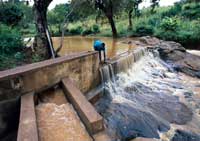
to generate electricity from
small-scale hydroelectric
power schemes
Image courtesy of Practical
Action / Zul Mukhida
In Kenya, 96% of people have no access to grid electricityw4. A community from Mbuiri, a village north of Nairobi, has channelled part of a river to generate electricity in small-scale hydroelectric power schemes. A video about micro-hydro energy in Kenya and other background material about this Practical Action project can be found onlinew5.
This sets the scene for the Moja Island activity.
Materials
All materials required to run the activity can be downloaded for free from the Practical Action websitew6, including video clips showing renewable energy in action. You will need the file entitled ‘Powerpoint presentation introducing activity’.
The activity is designed for four groups of up to four students each. A large class could be split into eight groups, with two groups working on each of the Moja communities. For each group of students, you will need:
- A map of Moja Island (the original map on the Practical Action website will work in colour. A black and white version is available via the Science in School websitew7)
- A set of renewable energy fact cards that provide background information, including the advantages and disadvantages of eight renewable energy sources
- One of the four Moja Island community cards that give background information on the communities living on Moja Island
- A renewable energy choices worksheet.
Introduction to the activity
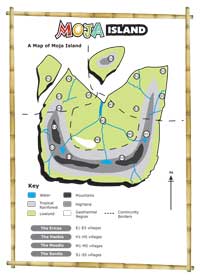
Click to enlarge image
Image courtesy of Revellation
design
Introduce Moja Island, using the downloadable PowerPoint® presentation to explain the main issues of meeting energy requirements in rural communities, and set the scene for the classroom activity. Discuss why there is little chance of the majority of people without access to mains electricity being connected in the near future.
- Moja Island is a small country situated off the east African coast in the Indian Ocean.
- It has no mains electricity.
- The 1450 islanders mainly use kerosene lamps and candles for light and wood for cooking food.
The task
- The Moja Island government has decided to invest money in generating electricity through small-scale renewable energy technologies. As scientists, your students have been asked to identify the most appropriate renewable energy options for the village communities on the island.
- Can the students think of some renewable energy options that might be suitable for Moja Island? Discuss briefly in class. Students may suggest options that they are already aware of, such as wind and solar power.
- Discuss the location of the island, providing the relevant background information: what is the climate (sunshine, wind and rain)? Are there tides? Are there waves?
- Split the class into four groups and distribute the materials. Each group will represent one of the four communities on Moja Island – the Ericas, Hankis, Moodis and Sandis, with five villages each.
- Allow approximately 40 minutes for each group to read through the cards with information on their community and the renewable energy sources, and to decide on the most appropriate energy solutions for the five villages within their community. They are given a choice of geothermal, solar, wind, hydroelectric, tidal or wave energy, biomass or biogas (see Table 1, below). From the cards, the students may, for example, decide that some communities may be more confident sourcing their energy either on land or at sea. Although cost is certainly an important factor, this is a separate issue and not part of this activity. Each group should record their results in the worksheet provided.
| Generation | Advantages | Disadvantages | Environmental impact | Energy provided |
|---|---|---|---|---|
| Geothermal energy | ||||
| Underground water is heated by hot rocks below Earth’s surface. The resulting steam can be used to turn turbines that then power generators to produce electricity. | It is free and available day and night. | Only available in certain parts of the world. Sometimes poisonous gases are given off. | Some impact from the installation of the equipment that is needed to direct steam to turbines. For example, infrastructure such as roads will be needed to transport the building materials to the site, and the equipment itself takes up a lot of space. | One geothermal power plant provides enough electricity for 20 dwellings. |
| Solar energy | ||||
| Uses the Sun’s energy in two main ways: 1) To heat solar panels which can be used to heat water 2) In solar cells which can transform light energy into electricity. |
The Sun’s energy is freely available whenever the Sun is shining. | Solar panels require continuous sunshine, unless the energy can be stored in batteries. Solar cells are expensive to buy. | Some minor impact as a large area may be needed for solar cells (about 2 m2 per cell). | A single photovoltaic cell provides enough electricity for 5 dwellings. |
| Wind energy | ||||
| The wind turns blades, which drive a turbine; this in turn drives the generator to produce electricity. | Whenever the wind blows electricity is generated. | Large numbers of turbines are needed to produce a large amount of energy. Only works well in windy places (hills or offshore). | Some impact from installing wind turbines, such as noise and danger to birds. Bats are particularly affected by the changes in pressure caused by the turbines. | Two wind turbines provide enough electricity for 15 dwellings. |
| Hydroelectric energy | ||||
| Running water is diverted from a river to turn a waterwheel or turbine, which in turn drives the generator to produce electricity. | If there is good a supply of rain, there will always be water to produce electricity. | Only suitable for hilly areas with rivers. | Some impact from diverting rivers. This may upset the ecology of the area or the fertility of surrounding land. | A single hydroelectric plant provides enough electricity for 40 dwellings. |
| Tidal energy | ||||
| A barrage is placed across the mouth of an estuary. Tidal water passes through holes in the barrage, driving a turbine which in turn drives the generator to produce electricity. | Wherever there are tides, electricity is generated. | Barrages are expensive to build. | Some impact through barrier installation, which can disrupt the tidal flow to shore and hence the movement of nutrients and organisms, including migrating fish. | A single barrage provides enough electricity for 25 dwellings. |
| Wave energy | ||||
| Buoys (floats) are placed in the sea, and convert wave movement into vertical movement inside the buoy. This drives a turbine which in turn drives the generator to produce electricity. | Whenever there are waves, electricity is generated. | A large number of buoys are needed to generate enough electricity for a town. The technology only works where there are big waves. | Minimal impact is caused, and only when there are many floats in the water. | Ten buoys provide enough electricity for 10 dwellings. |
| Biomass | ||||
| Solid organic materials (wood, dung, sugar cane) are combusted and the heat released is used to produce steam, which drives a generator to produce electricity. | Plants are renewable; they can be grown continuously. | Combustion produces carbon dioxide and other pollutants. | Pollution caused by combustion. | A single generating plant provides enough electricity for 25 dwellings. |
| Biogas | ||||
| Plants and animal manure are decomposed (allowed to rot) in a tank. The resultant methane gas is combusted and the heat released is used to produce steam, which in turn drives a generator to produce electricity. | Uses natural waste products. | Combustion produces carbon dioxide and other pollutants. | Pollution caused by combustion. | A single generating plant provides enough electricity for 20 dwellings. |
- Ask the students to present their decisions to the whole class – at this stage, without giving reasons.
- Summarise the activity by counting the number of groups that chose to use each renewable energy source using Table 2, below. Which were the most popular renewable energy options for Moja Island?
Energy sources Number of groups Table 2: The most popular energy choices Wind Solar Water (hydroelectric, wave, tidal) Geothermal Biological (biomass, biogas) - Finally, ask the students to explain their energy choices. There are no right or wrong answers – the most important point is that students are able to justify their decisions.
Acknowledgement
The Moja Island activity was developed by the Practical Actionw2 team (Bren Hellier, education officer, and Peter Crowther, freelance education consultant).
References
- International Energy Agency (2010) World Energy Outlook 2010. Paris, France: OECD / IEA. ISBN: 9789264086241
Web References
- w1 – The United Nations Development Programme works with 166 countries to improve their inhabitants’ lives. See: www.undp.org
- w2 – For more information on Practical Action, see: www.practicalaction.org
- w3 – Read more about Practical Action’s small-scale wind power project in Sri Lanka and watch a video about it here: http://practicalaction.org/energy-advocacy/access-wind-sri-lanka
- w4 – To read the United Nations Development Programme 2003 report on the Mbuiri hydropower project, see: http://sgp.undp.org/download/SGP_Kenya1.pdf
- w5 – To find out more about Practical Action’s micro-hydro power project in Kenya, including a video, see: http://practicalaction.org/our-work/ourwork_energy?id=microhydro
- w6 – You will find all materials required for the activity here: www.practicalaction.org/moja-island-1
- w7 – You can download the black and white version of the Moja Island map here.
Resources
- For further activities and free downloadable material on renewable energy, visit: www.practicalaction.org/education/renewable-energy-resources
Review
The article and teaching activity can be used in any science classroom anywhere in the world, in any subject that includes renewable energy sources in its curriculum. In fact, since the topic requires knowledge from many disciplines, including biology, physics, chemistry, geography, geology, meteorology, and even economics and mathematics, this teaching activity could be an ideal case for studying and learning through interdisciplinary projects.
The materials for the teaching activity can be freely downloaded. The students assume the role of scientisfic experts and in small groups decide which kind of renewable energy sources would be most appropriate to use in a specific fictitious environment.
The article could trigger discussions on whether any renewable energy source is suitable to be used in a particular environment. As the answer would most likely be negative, discussions could then focus on specifying which criteria a specific environment would have to fulfil to be a good candidate for a given renewable energy source.
Teachers may also use the method presented to study different topics.
Michalis Hadjimarcou, Cyprus





